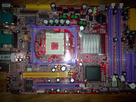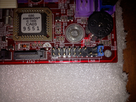First post, by parhelia512
Hello Everybody !
I would like to build a retro XP computer using a Soltek SL-B8E-F Motherboard.

This is a small motherboard from a Soltek QBIC Shuttle Clone.
This motherboard has a strange problem.
Once plugged, the motherboard starts, the POST (i can ear the "BEEP") then stops.
I'm not able to start the motherboard using the Power Switches on the motherboard, i have to unplug the power supply and plug it again and...same thing.
Same behaviour without CPU and memory (Power on, POST and power off).
When i'm probing the voltages on the power switch pins, i can see both are receiving 5V, which, to my knowledge, is not normal...
Can you please help me to find what's going wrong with this board ?
Thank you !

